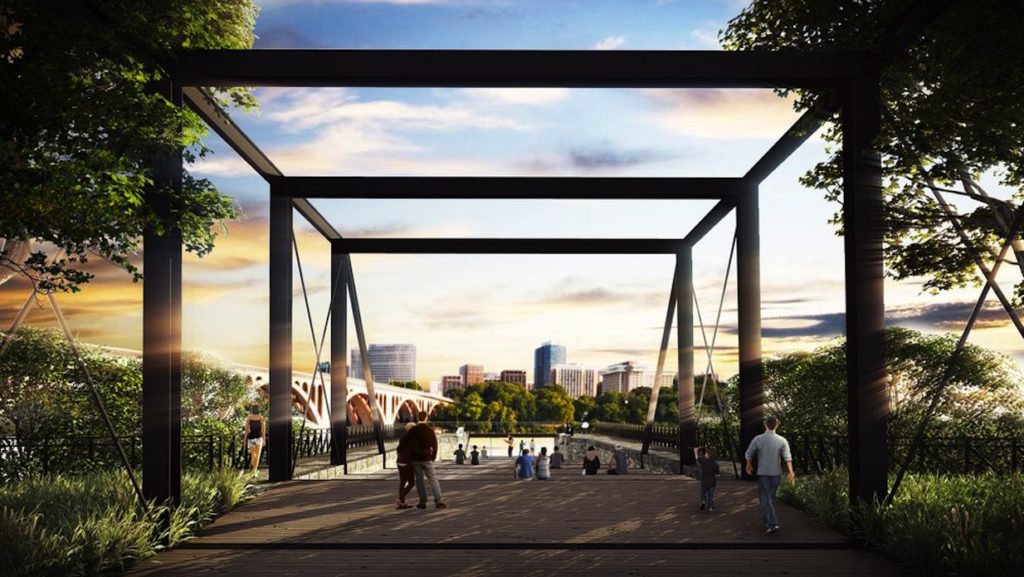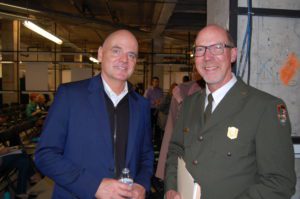Town Topics Nov. 8, 2017
By • November 8, 2017 0 421

By Peggy Sands and Elizabeth Pankova
Ideas Unlocked at Public Meeting on Canal Plans

Speakers James Corner and Kevin Brandt.
Some 150 persons concerned about the decline of the historic C&O Canal, an essential part of Georgetown’s identity for more than 180 years, attended a public meeting Nov. 2 to share ideas and comments about the plans for its renewal.
The canal was a highly traveled working waterway in the 1800s. Now, the once state-o-the- art locks, engineered walls and working towpaths have deteriorated. “There is no longer a mule-drawn canal boat to add color to Georgetown’s historic charm and there are limited opportunities to celebrate nature, art, culture and the community along the mile of canals in historic Georgetown,” states Georgetown Heritage, an organization founded to “breathe new life into the C&O Canal through Georgetown.”
In January of 1971, the area became a national park, one of the few that is partly located in an urban environment like Georgetown. Its refurbishment falls under the National Historic Preservation Act.
A master plan developed by Georgetown Heritage, the National Park Service and the Georgetown Business Improvement District would restore the stone structures of the canal walls, improve the towpaths and bridges and add seating, water fountains and lighting along the canal’s public areas, according to Alison Greenberg, executive director of Georgetown Heritage.
At the second of three public meetings to gather public written comments about alternative design concepts, required by the National Environmental Policy Act, expanded plans were presented by Kevin Brandt, superintendent of the C&O Canal National Historical Park. The
project area has been newly defined to include the portion of Rock Creek Park from Lock 1 to Mile Post 0. This would make a seamless connection between the two areas, according to Brandt.
In addition, from feedback garnered at the first public planning meeting in June, additional landscaping and gateway designs were incorporated. These include areas of serenity as well as small areas for music and public programs that “highlight the canal’s diversity of stories that evoke the past and celebrate the present,” according to Greenberg.
Following the formal presentation by the Brandt, attendees shifted between four planning stations to ask detailed questions and prepare comments about four aspects of the refurbishment plan: the crossings, the landscapes, the locks and the gates.
Dec. 11 marks the end of the comment period. Comments to be incorporated into the final concepts document can be submitted electronically or postmarked on or before that
date. For more information, and to comment, visit parkplanning.nps.gov. An environmental assessment is to be prepared by next spring.
‘Summer Garden’ Snafu at Booeymonger
 Booeymonger, the sandwich place on the corner of Potomac and Prospect Streets NW, “has been a favored and popular meeting place for Georgetown students and neighbors for decades,” said Advisory Neighborhood Commissioner Rick Murphy during discussion of a request to add a “summer garden” on the side of the property at the Oct. 30 ANC
Booeymonger, the sandwich place on the corner of Potomac and Prospect Streets NW, “has been a favored and popular meeting place for Georgetown students and neighbors for decades,” said Advisory Neighborhood Commissioner Rick Murphy during discussion of a request to add a “summer garden” on the side of the property at the Oct. 30 ANC
meeting. “But in the past year, under new ownership, the deli’s relationship with the neighbors has gone downhill. This request will now be a hard sell to approve.”
Owner Rummana Choudhury claims that designating as a summer garden a few sidewalk tables and chairs that have sat in a fenced area on Potomac Street for years would amount to no change at all. But Murphy disagreed.
“At least 15 neighbors strongly oppose the application,” he said. The ANC concluded that close attention would be paid to the application process. Designation as a summer garden would allow alcoholic beverages to be legally consumed there.
Let There Be Light in Georgetown
Proposals and charts showing the possible placement of LED lights in Georgetown’s residential areas were presented at the Oct. 30 Advisory Neighborhood Commission meeting by Sam Zimbabwe, chief project delivery officer with the District Department of Transportation.
“Safety of residents and visitors using our streets is the top priority of the District’s Streeetlight Modernization Project,” said Zimbabwe. The LED lights, which will eventually replace all traditional streetlights in the District, will improve visibility, lighting consistency and color recognition, both for humans and for closed-circuit television, according to DDOT. The 4000-Kelvin lights will also reduce energy consumption by about 50 percent.
Streetlight fixtures will remain consistent. Two models will be used: teardrop at the intersections and post-top in the mid-blocks. Models have been installed on Volta
Street. “Come and have a look,” said Volta Street resident Joe Gibbons, who chairs the ANC.
Decision on Heating Plant Landmark Status Pending
On Nov. 2, the District of Columbia’s Historic Preservation Review Board decided to designate the West Heating Plant at 29th and K Streets NW as a historic landmark, reversing a decision it had made in April of 2015 not to designate it as such. Now, the final decision has been postponed to the Nov. 16 hearing, in order to allow further statements from concerned parties addressing partial or full demolition of the building.
The abandoned 1948 heating plant has been proposed for reconstruction into the Four Seasons Residences by Georgetown real estate developer Richard Levy’s Levy
Group. Designation as a historic landmark could jeopardize those plans. The placement of the building on the National Register of Historic Places for listing as “of historical significance” — if the owner does not object to that designation — could mean the building cannot undergo substantial change. The review board determined that the property meets the criteria for historic integrity and significant historic contributions.
All but one of the commissioners on the Georgetown-Burleith Advisory Neighborhood Commission opposed the designation. But Commissioner Jim Wilcox, while agreeing the building was “very unattractive” and that “improvements should be made as soon as possible,” said there were unresolved questions about the developer’s structural report. “Rehabilitation is more feasible,” he concluded. Wilcox also wrote that the “demolition is illegal,” since the sale was predicated on the building being rehabilitated.
Close Parkway at Kennedy Center Riverfront to Cars?
A 15-year-old idea to make the riverfront portion of Rock Creek Parkway that passes under the Kennedy Center terrace a thoroughfare for pedestrians and bicyclists only was recently revived by the Georgetown and Foggy Bottom advisory neighborhood commissions.
At October meetings of the two ANCs, both commissions passed resolutions urging the District Department of Transportation to allocate $500,000 for a study that would use Interstate 66 as a traffic bypass from Virginia Avenue to a “point just south and below the Roosevelt Bridge.”
Proponents, including Foggy Bottom Advisory Neighborhood Commissioner William Kennedy Smith, have said the change — whether implemented temporarily using low-cost measures or permanently by altering some roadways — would create a safe, appealing area for pedestrians and bicyclists to get from Georgetown to the National Mall; free up riverfront access to and from the performing arts center; and relieve widespread traffic congestion caused by drivers who could easily take an alternate route.
“I always thought it was a waste — the fact that you had all this freeway sitting behind the Kennedy Center, and you have Rock Creek Parkway being used as a commuter route,” said Smith.
But Sam Zimbabwe, DDOT’s chief project delivery officer, said at the Oct. 30 meeting of the Georgetown ANC that, while the agency was considering the idea of a bypass study, identifying money for the concept in its 2018-2022 Statewide Transportation Improvement Program budget by 2018 may not be feasible.
GU’s Love Saxa Group Keeps Funding
After two hearings, Georgetown University’s Student Activities Commission voted 8-4 not to defund Love Saxa, a pro-heterosexual marriage group. (“Hoya Saxa” is the university’s official cheer.)
The hearings were a result of a complaint submitted by two Georgetown students, calling for the end of university funding for Love Saxa. They claimed that, by excluding members of the LGBTQ community from their definition of healthy and normal relationships, the club fosters hate and alienation. The complainants also argued that the club violates university
policy, which states that groups whose purpose is to foster intolerance cannot receive recognition or funding from the university.
Love Saxa members responded to the complaint by stating that the club does not aim to exclude any group or individual on campus, but rather offers a supportive environment for people with similar opinions on the definition of marriage and sex. Love Saxa also stated that their views on marriage are aligned with those of the Catholic Church, and therefore Georgetown University. “We are not interested in promoting hatred of any kind,” wrote Love Saxa on its Facebook page.
The Student Activities Commission’s first hearing, on Oct. 31, lasted three hours and was adjourned without a decision. On Nov. 2, the commission went into special session and made the decision not to take action against Love Saxa. The group will continue receiving $250 a year from Georgetown’s student activities fund. Love Saxa responded: “We are grateful to everyone who supported us in this process. We look forward to engaging in productive dialogue with those who disagree with us on issues of sexuality, marriage, and the family.”

